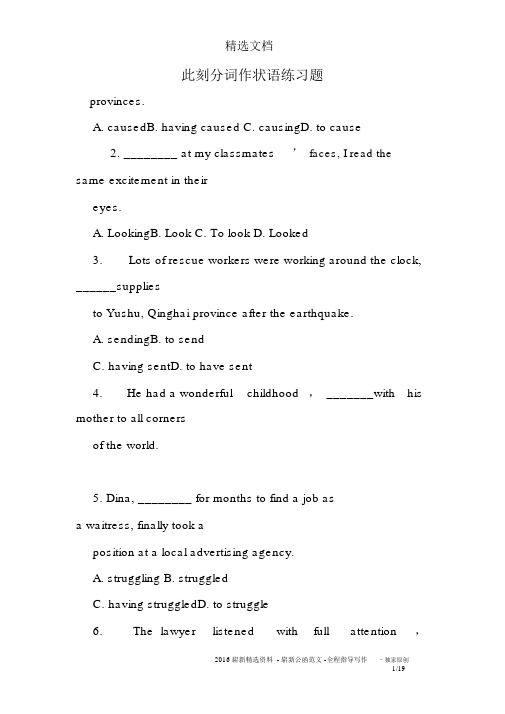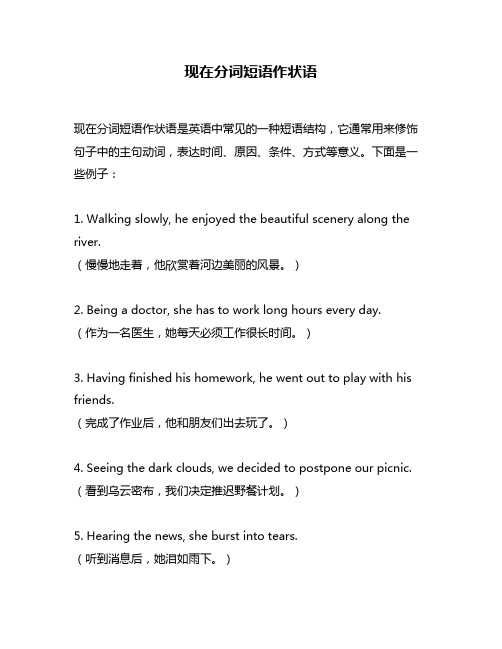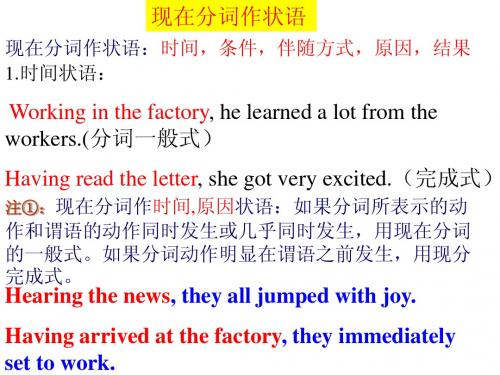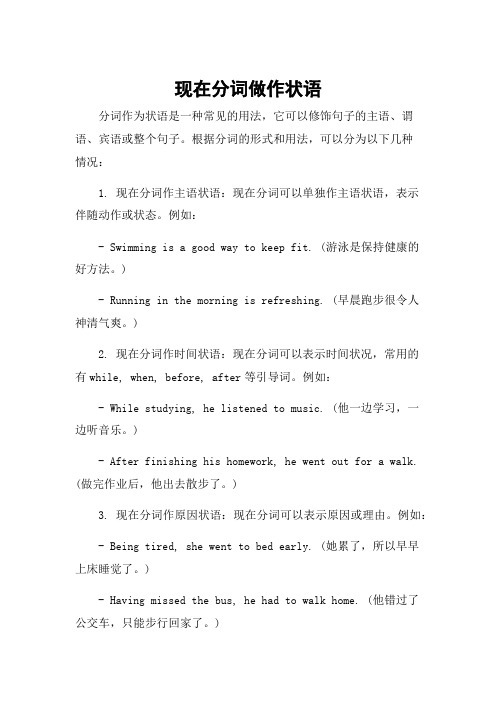现在分词做状语练习
(完整word版)现在分词作状语练习题

此刻分词作状语练习题provinces.A. causedB. having causedC. causingD. to cause2. ________ at my classmates’ faces, I read the same excitement in theireyes.A. LookingB. LookC. To lookD. Looked3.Lots of rescue workers were working around the clock, ______suppliesto Yushu, Qinghai province after the earthquake.A. sendingB. to sendC. having sentD. to have sent4.He had a wonderful childhood,_______with his mother to all cornersof the world.5.Dina, ________ for months to find a job asa waitress, finally took aposition at a local advertising agency.A. strugglingB. struggledC. having struggledD. to struggle6.The lawyer listened with full attention,________ to miss anypoint.注意是分词的否认还是不定式的否认A .not trying B.trying notC.to try notD.not to try7. The news shocked the public, _______to greatconcern about students’safety at school.8._______ from heart trouble for years, Professor White has to take somemedicine with him wherever he goes.A. SufferedB. SufferingC. Having sufferedD.Being suffered9. Finding her car stolen, _______.A. a policeman was asked to helpB. the area was searched thoroughlyC. it was looked for everywhereD. she hurried to a policeman for help10.He sent me an e-mail, ________ to get further information.A. hopedB. hopingC. to hopeD. hope11.While building a tunnel through the mountain, _______.A. an underground lake was discoveredB. there was an underground lake discoveredC. a lake was discovered undergroundD. the workers discovered an underground lake12.Suddenly, a tall man driving a golden carriage ________ the girl andtook her away, ________ into the woods.A. seizing; disappearedC. seizing; disappearing B. seized; disappearedD. seized; disappearing13._______ in the queue for half an hour, Tomsuddenly realized that hehad left his wallet at home.A. To waitB. Have waitedC. Having waitedD. To have waited14.European football is played in0 countries,______ it the most popularsport in the world.A. makingB. makesC. madeD. to make15.Though _______ money, his parents managed tosend him touniversity.A. lackedB. lacking ofC. lackingD. lackedinKey: 1-CAADC-10 BCCDB 11-1DDCAC分词作状语1.分词或分词短语作状语时,能够表示时间、原由、退步、条件,方式或陪伴情况。
现在分词短语作状语

现在分词短语作状语现在分词短语作状语是英语中常见的一种短语结构,它通常用来修饰句子中的主句动词,表达时间、原因、条件、方式等意义。
下面是一些例子:1. Walking slowly, he enjoyed the beautiful scenery along the river.(慢慢地走着,他欣赏着河边美丽的风景。
)2. Being a doctor, she has to work long hours every day.(作为一名医生,她每天必须工作很长时间。
)3. Having finished his homework, he went out to play with his friends.(完成了作业后,他和朋友们出去玩了。
)4. Seeing the dark clouds, we decided to postpone our picnic. (看到乌云密布,我们决定推迟野餐计划。
)5. Hearing the news, she burst into tears.(听到消息后,她泪如雨下。
)6. Knowing little about computers, he asked for help from his friend.(对电脑知之甚少,他向朋友求助。
)7. Feeling tired after a long day's work, she went straight to bed. (一天辛苦工作后感到疲惫不堪,她直接上床睡觉了。
)8. Hoping to win the game, they practiced hard every day.(希望赢得比赛,他们每天都刻苦练习。
)以上是一些常见的现在分词短语作状语的例子,它们都能够起到修饰句子、表达含义的作用。
在使用时需要注意语境和语法结构,避免出现歧义或错误。
现在分词做状语

现在分词做状语现在分词被用作状语。
其实大多数情况下,现在分词和它的关联成分一起作状语,也就是现在分词短语作状语,相当于它对应的状语从句。
大多数情况下,可以放在句首,也可以放在句尾。
例:1.作时间状语Entering the classroom, the students began to read English.一进教室,学生们就开始读英语。
(相当于As soon as/After they entered the classroom)2.作原因状语The girl doesn't feel like eating any food, being ill for a few days.这个女孩不想吃任何食物。
她已经病了几天了。
(相当于Because she has been ill for a few days或Because of her being ill for a few days)3.作条件状语Working hard, he will succeed in passing the English examination.如果他努力学习,他能通过英语考试。
(相当于从句If he works hard)4.作让步状语Being tired after work, he still insists on studying French.下班后很累,他仍然坚持学习法语。
(相当于Though he is tired after work或Though tired after work)5.作结果状语People all over the world sing the song, making it popular.全世界的人都唱这首歌,这使它流行起来。
(相当于so that they make it popular)6.作方式状语Travelling by car , we enjoyed many beautifull places.开车旅行时,我们欣赏了许多美丽的地方。
现在分词做状语

4.现在分词作原因状语:
Seeing nobody at home, she decided to leave them a note. Not knowing her address, we couldn’t get in touch with her. Being so poor in those days, we couldn’t afford to send the boy to hospital. 注: Having worked among the peasants for many years, he knew them very well.(分词完成式的肯 ( 定式) 定式) Not having received an answer, he decided to write another letter.(分完否) (分完否)
巩固练习
1.The secretary worked late into the night, ___ a long speech for the president. A.to prepare B.preparing C.prepared D.was preparing 2.The visiting minister expressed his satisfaction with the talks, ___ that he had enjoyed his stay here. A.having added B.to add C.adding D.added 3.European football is played in 80 countries, ____ it the most popular sport in the world. A. making B.makes C.made D.to make
现在分词作状语

现在分词作状语【典例展示】1.【2013重庆30】When I was little, my mother used to sit by my bed, _______ me stories till I fell asleep.A. having toldB. tellingC. toldD. to tell2. 【2013福建22】_______ basic first-aid techniques will help you respond quickly to emergencies.A. KnownB. Having knownC. KnowingD. Being known3.【2013湖南25】The sun began to rise in the sky, _______ the mountain in golden light.A. bathedB. bathingC. to have bathedD. have bathed4.【2013浙江7】_______ how others react to the book you have just read creates an added pleasure.A. HearingB. HearC. Having heardD. To be hearing5.【2013江苏24】Lionel Messi, _______ the record for the most goals in a calendar year, is considered the most talented football player in Europe.A. setB. settingC. to setD. having set6.【2013新课标I卷35】The sunlight is white and blinding, _______ hard-edged shadows on the ground.A. throwingB. being thrownC. to throwD. to be thrown7.【2013新课标II卷5】I got to the office earlier that day, _______ the 7:30 train from PaddingtonA. caughtB. to have caughtC. to catchD. having caught8.【2013山东33】_______ at the cafeteria before, Tina didn’t want to eat there again.A. Having eatenB. To eatC. EatD. Eating9.【2013四川8】_______ which university to attend, the girl asked her teacher for advice.A. Not knowingB. Knowing notC. Not knownD. Known not10.【2013北京24】_______ the course very difficult, she decided to move to a lower level.A. FindB. FindingC. To findD. Found【知识诠释】一、现在分词具有形容词和副词的特征,用作副词时,充当时间、条件、原因、伴随、结果、方式以及让步状语。
现在分词作状语

现在分词作状语1)在某些动词(a)或复合谓语(b)后可用现在分词(短语)作状语a.He spent a lot of moneymodernizing the house,他花了很多钱,把房子摘得很新潮。
we wasted a whole afternoon trying Io repair the car,我们试着修车浪费了整个下午。
She'sgoing shopping this afternoon.她今天下午要去购物。
The boy came running into the house男孩跑进屋来。
He rode away whistling.他吹着口哨骑车走了。
Sophia sat waiting on the sofa in the sitting-room.索菲娅坐在客厅沙发上等着。
I stood watching her,not knowing what to do,我站着看着她,不知如何是好。
She was lying in bed crying.她躺在床上哭。
He pretends to busy himself writing.参他假装忙着写东西。
Some left the hall stilt weeping,有些人离开大厅时还在哭泣。
The manager approached ussmiling。
经理笑着走近我们。
He ran out of the house shouting,他喊叫着跑了出来。
b.The girls are busy making an垆cia11owers.姑娘们在忙着做纸花。
She was in the kitchenpreparing supper,她在厨房做晚饭。
Many vehicles there are idle awaiting repairs,许多车辆停在那里等候修理。
Over 20,000 people were there watching the football match. 两万多人在那里观看足球赛。
现在分词作状语练习

After he heard a strong sound, he went out of the room for a look. = Hehe went out of ..
As the girl was seriously ill, she was taken to hospital immediately.be - being Being seriously ill, the girl was taken to ….
Having eaten too much for supper, he couldn’t go to sleep.
• 2.This book became well known all over the world after it had been translated into many different languages.
B. makes D. to make
3.”Can’t you read?” Mary said ______ to the notice.
A. angrily pointing B. and point angrily C. angrily pointed D. and angrily pointing
•Having been translated into many different languages, this book became well known all over the world .
注意:
--- ing形式(短语)的否定形式 常在其( 前面 )加not 。
Not knowing his address, I could do nothing but stay at home and wait.
现在分词做作状语

现在分词做作状语分词作为状语是一种常见的用法,它可以修饰句子的主语、谓语、宾语或整个句子。
根据分词的形式和用法,可以分为以下几种情况:1. 现在分词作主语状语:现在分词可以单独作主语状语,表示伴随动作或状态。
例如:- Swimming is a good way to keep fit. (游泳是保持健康的好方法。
)- Running in the morning is refreshing. (早晨跑步很令人神清气爽。
)2. 现在分词作时间状语:现在分词可以表示时间状况,常用的有while, when, before, after等引导词。
例如:- While studying, he listened to music. (他一边学习,一边听音乐。
)- After finishing his homework, he went out for a walk. (做完作业后,他出去散步了。
)3. 现在分词作原因状语:现在分词可以表示原因或理由。
例如:- Being tired, she went to bed early. (她累了,所以早早上床睡觉了。
)- Having missed the bus, he had to walk home. (他错过了公交车,只能步行回家了。
)4. 现在分词作结果状语:现在分词可以表示结果,常用的情况有so, therefore等引导词。
例如:- He studied hard so as to pass the exam. (他努力学习,以便通过考试。
)- The weather was bad, so they stayed at home. (天气不好,所以他们呆在家里。
)。
- 1、下载文档前请自行甄别文档内容的完整性,平台不提供额外的编辑、内容补充、找答案等附加服务。
- 2、"仅部分预览"的文档,不可在线预览部分如存在完整性等问题,可反馈申请退款(可完整预览的文档不适用该条件!)。
- 3、如文档侵犯您的权益,请联系客服反馈,我们会尽快为您处理(人工客服工作时间:9:00-18:30)。
聚焦-ing形式作状语
-ing形式作状语,可表示时间、原因、方式、伴随、条件等。
如:
1. She sat at the desk reading a newspaper. (伴随)
2. Hang Wei went to school, taking a train. (方式)
3. While reading the book, he nodded from time to time. (时间)
4. Not having received a reply, we wrote again. (原因)
5. Heating water,we can change it into vapor.(条件)
注意:①-ing形式作状语,其逻辑主语应与句子的主语一致。
②-ing形式前可有while, when, unless, though, if等连词。
1. _______ from heart trouble for years, Professor White has to take some medicine with him wherever he goes. (上海2001春)
A. Suffered
B. Suffering
C. Having suffered
D. Being suffered
2. Finding her car stolen, _______. (上海2001)
A. a policeman was asked to help
B. the area was searched thoroughly
C. it was looked for everywhere
D. she hurried to a policeman for help
3. He sent me an e-mail, ________ to get further information. (上海2000)
A. hoped
B. hoping
C. to hope
D. hope
4. While building a tunnel through the mountain, _______. (上海2000春)
A. an underground lake was discovered
B. there was an underground lake discovered
C. a lake was discovered underground
D. the workers discovered an underground lake
5. Suddenly, a tall man driving a golden carriage ________ the girl and took her away, ________ into the woods. (上海2004春)
A. seizing; disappeared
B. seized; disappeared
C. seizing; disappearing
D. seized; disappearing
6. _______ in the queue for half an hour, Tom suddenly realized that he had left his wallet at home. (北京2004)
A. To wait
B. Have waited
C. Having waited
D. To have waited
7. European football is played in 80 countries, ______ it the most popular sport in the world. (NMET 1998)
A. making
B. makes
C. made
D. to make
8. ______ the programme, they have to stay there for another two weeks. (广东2004)
A. Not completing
B. Not completed
C. Not having completed
D. Having not completed
9. Though _______ money, his parents managed to send him to university. (上海2002)
A. lacked
B. lacking of
C. lacking
D. lacked in
10. Having been attacked by terrorists, _______. (上海2004)
A. doctors came to their rescue
B. the tall building collapsed
C. an emergency measure was taken
D. warnings were given to tourists
Key: 1-5 CDBDD 6-10 CACCB。
